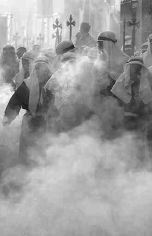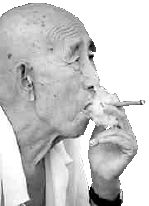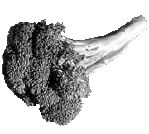
Jaime Puebla, The Associated Press Incense, burned here by Catholic worshippers, contains high levels of polycyclic hydrocarbons, a family of highly carcinogenic chemicals. |

Cigarette Smoking |

Punk Hair |

Broccoli |

Peanuts |

Glass of milk. |
Airplane rides, broccoli, sex, hydro wires and mothballs.
Just when the list of things that cause cancer seemed incapable of growing any longer, scientists have added another culprit: incense-burning.
This week, Taiwanese researchers reported finding benzopyrene, which causes lung cancer, at levels 40 times higher in a Buddhist temple than in houses of smokers.
Is it any wonder people think, as the singer Joe Jackson wails, "Every-thing, gives you can-cer"?
But how frightened should people be of new car interiors, which emit carcinogenic fumes? Or of red wine, which contains compounds that cause bladder cancer in rats? The answer, say cancer experts, is not at all.
If you really want to reduce your cancer risk, don't smoke, have a soft bowel movement, stay out of the sun and use condoms, says Robert Buckman, author of What You Really Need to Know About Cancer.
"The things that we can do to prevent cancer are incredibly boring," says Dr. Buckman, a professor of medicine at the University of Toronto.
"If you can demonstrate that something everybody does has a chance of increasing one of the rare cancers, whether it's true or not, you sell newspapers. It's exactly like Jaws ... in which the premise is going swimming can lead to your death by shark attack."
A report that something may cause cancer is more than headline fodder.
We live in an era of class-action lawsuits, and the precautionary principle, in which the remote chance a substance may lead to DNA damage in our bodies, can destroy companies and even industries.
The media are only part of the process, since they are generally only reporting what scientists have discovered.
"Unfortunately, these stories are very often not generated by people who have billions of dollars in grants," Dr. Buckman says.
"They're very often generated by junior [scientists] early in their careers who are very often applying for their first research grant, for $20,000 or $30,000, and it's a wonderful shortcut to making people take a great deal of notice of research work that might not be a very big deal."
The Internet has amplified the panic and uncertainty over carcinogens.
"A while ago, there was a rumour going around that wearing a bra causes breast cancer," says Kerstin Ring, communications director of the Canadian Cancer Society. "It was a big e-mail thing. Lots of people got it. But it's a myth. Bras don't cause cancer."
Experts say one of the difficulties in understanding the true risk of cancer lies in numbers.
For example, women who take hormone pills face an increased relative risk of breast cancer of 30%. This sounds terrifying. But since most women face a 12% lifetime risk of getting breast cancer, taking hormone pills raises their absolute risk to about only 15%. Similarly, the news that long-term exposure to an industrial chemical may double the risk of liver cancer sounds bad. But the absolute lifetime risk of getting liver cancer is four in 1,000, which is exceedingly rare, if one considers a man's lifetime risk of prostate cancer is greater than 170 in 1,000.
"We are all exposed to carcinogens every day; motor vehicle exhaust being something that you hit almost as soon as you leave the door," says Paul Demers, an epidemiologist at the University of British Columbia.
"But the body has natural repair mechanisms that have evolved in order to protect us against some of these things. The more important [risk] factor is how much you're exposed to something."
For many of the things popularly thought to be a big cancer risk, such as hydro lines, the real risk is stress.
"I don't think there's any doubt that if it increases your stress level, that it can be detrimental, probably not in the form of cancer but probably in heart disease," Mr. Demers says. "Pretty much any stressor will have at least some effect."
Unlike heavy metals, which can accumulate in the body and cause damage to the nervous system, most carcinogens tend to be passed out of the body within hours. Among the rare exceptions are viruses such as human papilloma virus and hepatitis C, common natural pathogens that cause cervical and liver cancer respectively. But these are not the cause of panic in society. Instead, the makers of cellular telephones and the nuclear industry are attacked as risks to human health.
"I heard somebody on the radio four years ago say that he was so scared of electromagnetic fields that when he turns his microwave [oven] on, he ducks behind the counter," Dr. Buckman says.
"Well, he's an idiot."
Which brings matters back to incense-burning, which is popular with Hindu and Buddhist practitioners. Not long ago, a team of researchers led by Ta Chang Lin at the National Cheng Kung University in Taiwan collected air samples from inside and outside a temple in Tainan City and compared them to samples at a traffic intersection. The temple air was worse than car exhaust. It contained high levels of polycyclic aromatic hydrocarbons, a family of highly carcinogenic chemicals.
"There is a potential cancer risk," says Mr. Lin, a junior faculty member at the university. "We just cannot say how serious it is."
One of the best ways to judge whether something is a legitimate cancer risk is to look up the U.S. National Institutes of Health Report on Carcinogens. Now in its ninth version, it explains why a substance is deemed carcinogenic, its properties, use and production and how humans are exposed to it. The report also outlines what regulations are established in the United States and elsewhere to cope with any perceived risk. The Canadian Cancer Society also offers a less comprehensive guide on its Web site.
Ultimately, the biggest risk to getting cancer is just ageing, Mr. Demers says.
"If you live long enough, the chances are that you will get some kind of cancer," he says.
"The number of cancers is increasing, but that's because we're not dying of other things at a younger age."
IF YOU WANT TO WORRY, WORRY ABOUT THESE:
By certain measures, almost anything can cause cancer, even sun, vegetables and a woman's natural menstrual cycle. But these risks must be viewed in context, experts say. Here is a partial list of substances that cause, or are reasonably expected to cause, cancer. (Sources: U.S. National Institutes of Health, Canadian Cancer Society)
SUNLIGHT Solar radiation includes most of the electromagnetic spectrum. Of these bands, ultraviolet light is the most energetic and biologically damaging. The same goes for sun lamps and sun-beds. Studies show exposure is associated with cutaneous malignant melanoma.
MENSTRUATION Estrogen is a hormone secreted in higher quantities during a woman's period. It causes breast epithelial cells to divide, which may lead to DNA mutations. Because women now reach the age of menarche earlier and women put off bearing children until later in life, they have hundreds more periods than their grandmothers, raising their risk of breast cancer.
BROCCOLI Acetaldehyde, a human carcinogen, is the product of most hydrocarbon oxidations and is a normal intermediate in the respiration of most higher plants and is a natural component of apples, broccoli, coffee, grapefruit, grapes, lemons, mushrooms, onions, oranges, peaches, pears, pineapples, raspberries, and strawberries.
NEW CARS Vinyl chloride is a colourless, flammable gas with a faintly sweet odor emitted by PVC plastic. The average daily intake of vinyl chloride by inhalation is expected to be essentially zero for [most] of the population; however, new car owners are potentially exposed to relatively high levels due to volatilization of vinyl chloride from vinyl polymers within the car interior.
RED FIESTAWARE PLATES The ingredient in the glaze of these popular plates, which turns it red upon firing, is uranium, which is radioactive. Acidic foods such as vinegar and tomato sauce tend to leach out and absorb uranium from the glaze, but in 1981 the U.S. Food and Drug Administration said that the radioactivity levels of the plates were low enough not to be a health hazard. That's well enough, but it was later determined in 1994 that the red pieces were also leaking radon gas through cracks in the glaze at levels that are seven times higher than is considered safe.
SEX The human papillomavirus, which can be transmitted during sexual intercourse, can assist in causing cervical cancer. "Probably, the smaller number of partners you have, the smaller the risk," says Dr. Robert Buckman. "And with condoms, your chance of transmitting the virus associated with cancer of the cervix as well as the non-cancerous venereal diseases is markedly reduced."
SITTING AT HOME Indoor radon has been judged to be the most serious environmental carcinogen to which the general public is exposed. Radon is a naturally occurring radioactive gas and comes from the natural breakdown (radioactive decay) of uranium. Most soils contain varying amounts of uranium. It is usually found in igneous rock and soil. As many as 22,000 cases of lung cancer a year in North America may be caused by radon gas exposure. Radon seeps into homes from the surrounding soil through cracks and other openings in the foundation; as many as 20% of homes may have elevated levels.
CIGARETTE SMOKING Nearly 4,000 chemicals have been found in tobacco smoke, including acrolein, aromatic amines, benzene, formaldehyde, nitrosamines, polycyclic aromatic hydrocarbons, urethan, radioactive elements, arsenic, nickel, chromium and cadmium. All of these are carcinogenic.
FLIGHTS AT HIGH ALTITUDE Airplanes flying at altitudes of 12 km and above encounter intense radiation, particularly over the magnetic poles, where the Earth's magnetic field funnels charged particles into high concentrations. The crew of a regular flight from Toronto to Beijing faces, according to some experts, a greater risk of skin cancer than crashing.
CISPLATIN Irony of ironies, like many drugs used to treat cancer, cisplatin is carcinogenic. Since the 1970s cisplatin has been used in the treatment of testicular tumours; malignant melanoma; osteogenic sarcoma; carcinomas of the urinary bladder, lung (other than small cell), uterine cervix, and ovary; and squamous carcinoma of the head and neck region.
PUNK HAIR A risk of potential exposure to Direct Blue 6, a human carcinogen, may have existed for people using hair dyes that contained the compound. In addition, ingestion of Direct Blue 6 may occur if food is eaten that contained residues from packaging in which the dye was used.
ASBESTOS Actively promoted for export by the Chrétien government, asbestos when administered by inhalation, chrysotile, crocidolite, amosite, and anthophyllite induced cancers in rats and hamsters. Applications of asbestos materials to buildings and vehicle brake linings account for a significant amount of emissions to the atmosphere. Demolition of buildings with asbestos insulation or fireproofing may cause high atmospheric concentrations for relatively short periods of time. Disposal of mining and building material wastes in landfills also increases the distribution of asbestos into the environment.
PEANUTS Aflatoxins are toxic metabolites produced by certain types of fungi. The primary route of potential human exposure to aflatoxins is ingestion of contaminated food. Grains, peanuts, tree nuts, and cottonseed meal are among the foods on which aflatoxin-producing fungi commonly grow. Meat, eggs, milk, and other edible products from animals that consume aflatoxin-contaminated feed are additional sources of potential exposure. North Americans may consume up to an estimated 0.15-0.50 g of aflatoxins daily.
DDT Once used for the control of hundreds of insect pests in Canadian orchards, gardens, fields, and forests, DDT is still used around the world to control malaria. The mosquito larvicide is used as a residual spray for the eradication of malaria in dwellings, and as a dust in mass human delousing programs for typhus control. DDT has also been used for mothproofing clothing.
CHLOROFORM Foods such as dairy products, oils and fats, vegetables, bread, and beverages might contain small amounts of chloroform. Drinking water supplies may contain chloroform as a by-product of chlorination for disinfection purposes. The concentration of chloroform in drinking water increases with time. Miscellaneous uses of chloroform (4%) include as a solvent in the extraction and purification of some antibiotics, alkaloids, vitamins, and flavors; as a solvent for lacquers, floor polishes, artificial silk manufacture, resins, fats, greases, gums, waxes, adhesives, oils, and rubber; as an industrial solvent in photography and dry cleaning; as a heat transfer medium in fire extinguishers.